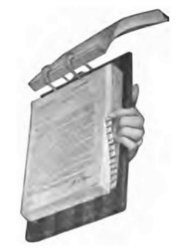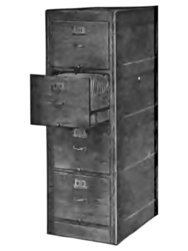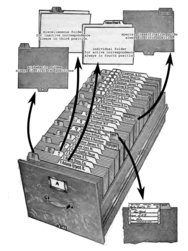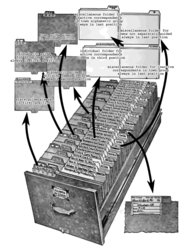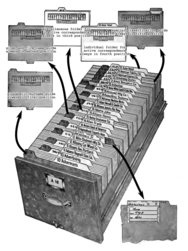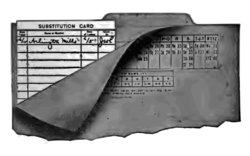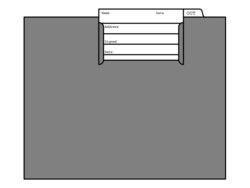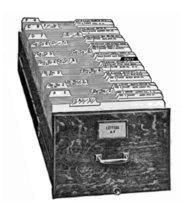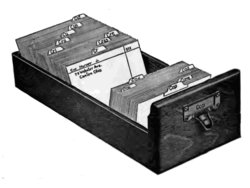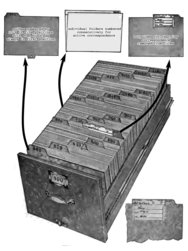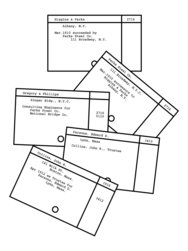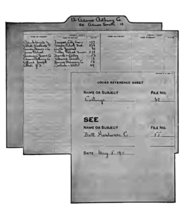Section XIX: Postal Information
(Condensed from the official postal guide, which should be consulted for points not covered in this section.)
Domestic mail is divided into four classifications, each taking a different rate of postage.
First-class matter includes all written matter and all sealed matter. Imitations or reproductions of typewriting and handwriting are considered first-class matter unless at least twenty copies are mailed at one time. The postal regulations specify that shorthand notes are to be considered as first-class matter.
It should be remembered, though, that a manuscript accompanied by the corrected proof sheets is considered as third-class matter. The first-class rate of postage is two cents for each ounce or fraction.
Second-class matter includes newspapers and periodicals which have been entered as second-class matter. The rate paid by the publishers varies according to the distance, etc. Newspapers and periodicals, however, which have been duly registered may be sent as second-class mail by others than the publisher at the rate of one cent for each four ounces or fraction. To be entitled to this rate the periodical must be complete.
Third-class matter embraces circulars, newspapers and periodicals not admitted to the second class, nor embraced in the term “book,” miscellaneous printed matter, proof sheets and manuscript copy accompanying them, and material printed in raised characters for use by the blind. The rate of postage is one cent for each two ounces or fraction, and the weight limit is four pounds. Parcels exceeding that limit are to be mailed as fourth-class matter.
Fourth-class matter (domestic parcel post) includes merchandise, farm products, books, catalogues, and all other mailable matter not included in the first, second, and third classes. On parcels weighing four ounces or less, except those containing books, seeds, or plants, the rate of postage is one cent for each ounce or fraction for any distance. On parcels weighing eight ounces or less, containing nothing but books, seeds, or plants, the rate of postage is one cent for each two ounces or fraction regardless of distance.
On other parcels coming under this classification the rate of postage varies according to the weight and distance, and the rate is determined by reference to the special scale provided by the post office.
Special Delivery - By adding ten cents to the regular postage a letter, postal card, or package will be delivered immediately upon its receipt if between the hours of 7 A. M. and 11 P. M. whether weekday, holiday, or Sunday. A “special delivery” stamp is sold for this purpose. Ordinary stamps may be used for this purpose if the words “Special delivery” are written across the face of the letter or package. A receipt is required of the person receiving the letter or article.
Registered Mail - For ten cents in addition to the regular postage any article except parcel-post packages may be registered. Special care is then given to it and a receipt procured from the person to whom it is addressed. By writing the words “Receipt demanded” across the face of the address of a registered article, an additional receipt will be procured and returned to the sender with the additional charge. In the case of loss, the post office department will indemnify the sender of the registered article mailed to a domestic post office for its full value up to $50.00 if sealed and paid for at letter rates, or $25.00 for third-class matter.
If for any reason it is desired to have registered mail returned to the sender instead of being delivered to the addressee, this may be done by application to the post master at the office of despatch. Domestic parcel-post packages cannot be registered, but may be insured for their actual value up to $100.00, the fee varying with the value declared. Packages maybe sent C. O. D. for a small fee which includes the cost of the money order used in making the remittance. The C. O. D. fee also includes the cost of insurance.
Foreign Mail - Foreign mail is divided into three classifications, first-class mail, parcel post, and book post.
The regular rate of postage on first-class foreign mail is five cents for the first ounce and three cents for each succeeding ounce or fraction. First-class mail may be sent to many countries at domestic postage rates. The more important are:
| Argentina | Cuba | New Zealand |
| Bolivia | Ecuador | Panama |
| Brazil | England | Peru |
| Canada | Ireland | Scotland |
| Colombia | Mexico | Wales |
The other less important foreign countries to which the domestic postage rate applies may be found in the latest edition of the postal guide. The rate of postage on post cards addressed to foreign countries is two cents.
The rate on “commercial papers” is five cents for the first ten ounces or less and one cent for each additional two ounces or fraction. This classification includes documents written wholly or partly by hand, but not possessing the character of personal correspondence; that is to say, such papers as deeds, insurance documents, correspondence course lessons and manuscript music. Sermons and packages of old letters or postal cards may be sent by mail to foreign countries at the rate and under the conditions applicable to commercial papers in the Postal Union mails.
Samples of merchandise not exceeding twelve ounces in weight may be sent at the rate of two cents for the first four ounces or less and one cent for each additional ounce or fraction. Articles of salable value are not considered as samples.
The rate of postage on foreign parcel post is twelve cents a pound, except that for certain countries an additional “transit charge” is made on each package regardless of the weight. As this transit charge varies from time to time the latest information must be secured from the post office.
Books and pamphlets up to four pounds, six ounces, may be sent to any foreign country at the rate of one cent for each two ounces or fraction.
Both domestic and foreign money orders may be obtained at nearly every post office. These are useful for making remittances where it is inconvenient or impossible to send checks or stamps. Money orders are issued only for sums of $100.00 or less. If a greater amount must be sent, it is necessary to purchase two or more money orders to make up the desired total.
The secretary should be familiar with the time of making up the mails for the different points to which his employer has occasion to write often so that in case of an urgent message he will know at what time the letter will be received. This is especially important in the case of the foreign mails, where the missing of a boat may sometimes mean a delay of a week or more.
Postage Meter - In offices having a great deal of first class mail, the time required for affixing the postage stamps complicates the problem of the mailing department. The post-office department has given its consent to the use of the Pitney-Bowes Postage Meter. This is a device for printing the amount of postage, the permit number and meter number on each letter. This meter may be taken to the post office from time to time and set by the clerk to make a certain number of impressions to be paid for in advance. When the meter has made that number of impressions the mechanism locks until readjusted at the post office. The color of the ink used on the printing mechanism is that of the stamp which would have been used otherwise. That is, when it is printing two cent impressions red ink is used, etc. The machine is so made that it will seal, post-mark, stamp, and count 250 pieces of mail in a minute.
Secretarial Problems: Review and Research Questions
-
What will be the postage on the following, mailed from New York:
-
A 3 ounce registered letter to San Francisco.
-
A 2½ ounce letter to Madrid.
-
A complete copy of the Saturday Evening Post, weighing 21 ounces, to Boston.
-
The original manuscript and proof sheets of a book, weighing one pound, to Los Angeles.
-
A 3¼ ounce letter to London.
-
What material is included in the classification “Second-class matter”?
-
What indemnity will be paid by the government in the case of loss of a registered letter or package?
-
Into how many classifications is domestic mail divided? Foreign mail? What are they?
Secretarial Problems: Laboratory Assignments
-
Compile a complete list of the foreign countries to which domestic rates apply on first-class mail. This list is to be distributed to the stenographers in the office. Consequently five copies will be needed. Make these at one typing.
-
You will weigh the packages which the manager will provide, and compute the postage.
Section XX: Alphabetizing
Before the secretary can make use of the knowledge gained of filing in the succeeding section, it will be necessary to study the subject of alphabetizing. Alphabetizing is simply a system of arranging matter to be filed in the order of the letters of the alphabet. One of the first steps to learn is the sequence of letters in the alphabet. This is simple, but, simple as it is, many students of filing display a surprising lack of knowledge of it. The accepted order of the alphabet is:
A, B, C, D, E, F, G, H, I, J, K, L, M, N, O, P, Q, R, S, T, U, V, W, X, Y, Z.
The next step is to learn the frequencies of combinations of letters as indicated by the guides in alphabetic files. This will be a matter of experience largely, but the acquisition of this knowledge will be hastened by studying the alphabetic divisions below.
The alphabetic divisions devised by filing equipment manufacturers are based on the analyses of thousands of names, and are therefore arranged on scientific principles. These may be studied with advantage by the secretary or filing clerk who has much of the work to do. Guides are provided for various subdivisions.
| 25 divisions | 40 divisions | 60 divisions |
| |
| A | A | AA-AM |
| BA-BL | BA | AN-AZ |
| BO-BY | BE-BI | BA |
| CA-CL | BL-BO | BE |
| CO-CZ | BR-BY | BI-BL |
| D | CA-CE | BO |
| E | CH-CL | BR |
| F | CO-CZ | BU-BY |
| G | DA-DE | CA-CE |
| HA-HE | DI-DY | CH-CL |
| HI-HY | E | COA-COP |
| I-J | FA-FL | COR-COZ-CR-CZ |
| K | FO-FY | DA-DE |
| L | GA-GL | DI-DO |
| MA-MC | GO-GY | DR-DY-EA-EK |
| ME-MY | HA | EL-EZ-FA |
| N-O | HE-HI | FE-FL |
| P-Q | HO-HY | FO-FY |
| R | I-J | GA-GE |
| SA-SE | KA-KI | GI-GO |
| SH-SO | KL-KY | GR-GY |
| SP-SY | L | HAA-HAP |
| T-Y-V | MA | HAR-HAZ-HEA-HEK |
| WA-WH | MC | HEL-HEZ-HI |
| WI-WY-X-Y-Z | ME-MI | HO |
| | MO-MY | HU-GY-I |
| | N-O | J |
| | PA-PH | KA-KE |
| | PI-PY-Q | KI-KY |
| | RA-RI | LA |
| | RO-RY | LE-LI |
| | SA-SC | LO-LY |
| | SE-SK | MAA-MAN |
| | SL-SQ | MAR-MAY |
| | ST-SY | MC |
| | T | ME |
| | U-V | MI-MOA-MOO |
| | WA-WE | MOR-MOZ-MU-MY |
| | WH-WI | N |
| | WO-WY-X-Y-Z | O |
| | | PA-PEA-PEM |
| | | PEN-PEZ-PF-PH-PI |
| | | PL-PY-Q |
| | | RA-RE |
| | | RH-RI-ROA-ROG |
| | | ROH-ROZ-RU-RY |
| | | SA |
| | | SC |
| | | SE-SH |
| | | SI-SM |
| | | SN-SO-STA |
| | | STE-STY |
| | | SU-SY-TA-TE |
| | | TH-TY |
| | | U-V |
| | | WA |
| | | WE |
| | | WH |
| | | WI |
| | | WO-WY-X-Y-Z |
Rules for Alphabetizing - Entries on cards, lists, etc., should always be placed in the following order:
-
Surname,
-
Comma,
-
Christian names (or initials),
-
Comma,
-
Title.
Example: Rockford, Roger Andrew, Dr.
If a company is a customer, enter under the company's title, with name of the officer following.
If the officer himself is the customer, enter under his name, in care of the company.
Great care must be taken to ascertain whether the first part of a company's name is a Christian or surname.
Example: The first names of Lewis Dick & Co. and Stewart Allison & Co. are Christian names and should be entered Dick & Co., Lewis; Allison & Co., Stewart. Not - Lewis, Dick & Co., or Stewart, Allison & Co.
Titles (Dr., Miss, Col., etc.,) should not be placed in parentheses. Mrs. is placed in parentheses only when the husband's name follows.
Example: Bruce, Anna W. (Mrs. Joseph Miller.) (A woman's Christian name is her legal name.)
Titles such as Esq., Jr., Mrs., Inc., Ltd., should be abbreviated.
Use Esq., and Mr., only on letters, envelopes, and stencils, never on cards, lists, or other records.
When filing, adhere to strict alphabetic order. That will place Jr. before Sr. and Miss before Mrs.
Examples:
| Manning, Henry, Jr. |
| Manning, Henry, Sr. |
| Manning, Martha, Miss |
| Manning, Martha (Mrs. Henry, Sr.) |
When The is the first word of a title or corporate name, disregard it and index under the name following.
Example:
| Metals Trading Corporation, The |
Every word of a title is to be taken into consideration when alphabetizing except a, an, and the, when they precede the title.
Examples:
| Hanover Flour Company, The |
| Hanover Forwarding Company, The |
If there is any doubt about strict alphabetic order, place one title directly before the other and imagine all the letters run together, thus:
| Hanoverflour. |
| Hanoverforwarding. |
The first difference will show which title should take precedence.
Many names are pronounced exactly alike but spelled differently.
-
File exactly as spelled.
-
When spelling differs only at the end of the word, no cross reference is necessary, since one spelling would follow immediately after the other.
| | Bailey | Fischer | Millar |
| | Baily | Fisher | Miller |
-
When spelling differs in the beginning of the word, make blanket cross references from one form of name (surname only) to the other.
| | Peirce | see also | Pierce |
| | Pierce | see also | Peirce |
When filing a group of one surname, bear the following rules in mind:
-
Nothing stands before something.
-
Initials always precede names beginning with the first letter.
Examples:
| Brown (Mrs.) |
| Brown, A. J. Z. |
| Brown, A. Seymour |
| Brown, Aaron |
Always file Mc as if spelled Mac.
Examples:
| MacDonald, A. P. |
| McDonald, Edward |
| MacDonald, F. M. |
| Macks, Frank |
| McNess, Malcolm |
| Macon, Albert |
Names that begin with numbers - These should be indexed as if spelled out.
Example: 3rd National Bank is filed as though written Third National Bank.
Names beginning with East, West, etc., as geographical designations, should be indexed under the important name.
Example: East St. Louis School Bldg. File under St. Louis and make a blank cross reference as follows:
| East |
| | See name of the locality followed by word East. |
Example: St. Louis, East
East, West, etc. - When East, West, etc., is part of title, corporate name, or locality, index under East, West, etc.
Examples:
| East Orange, N. J. |
| East Pittsburgh National Bank |
| North Adams, Mass. |
| West Side Men's Club |
When filing titles of a state, county, or city, file according to importance of government divisions.
Examples:
| New York (State) |
| New York (County) |
| New York (City) |
These are always to be placed at the beginning, other names and titles following in alphabetic order.
Examples:
| Washington (State) |
| Washington (County) Conn. |
| Washington (City) Conn. |
| Washington (City) D. C. |
| Washington (County) Fla. |
| Washington (County) Tenn. |
| Washington (City) Tenn. |
| Washington (The) |
| Washington Apartment |
| Washington, Booker T. |
| Washington Coffee Co., G. (cross reference) |
| Washington, George |
| Washington Hotel Co., Martha |
| Washington Irving High School |
| Washington, Mary |
| Washington Stadium Co. |
| Washington S. S. Co., (as though spelled out) |
| Washington Tanning Co. |
| Washington, Thomas |
| Washington Valley, N. J. |
Secretarial Problems: Review and Research Questions
-
What is the basis upon which the different alphabetic divisions of 60, 80, 100, etc. are divided?
-
In what order are entries on cards, lists, etc., placed?
-
What important factor is to be observed in listing company names?
-
When the word “the” is the first word of a title or corporate name, how will it be treated in alphabetizing?
-
How may strict alphabetizing be determined?
-
What disposition is made of names pronounced alike but spelled differently ?
-
When spelling differs in the beginning of a word how is it handled?
-
What rule is to be followed in filing groups of one surname?
-
What is done with names beginning with numbers, such as, 3rd National Bank?
-
When points of the compass are a part of titles, how are they treated?
-
What is the rule for filing titles of state, county, or city?
Secretarial Problems: Laboratory Assignments
-
Type the following names and indicate with letters the alphabetic subdivisions under which each will come, where eighty divisions are used. Refer to the charts:
-
Globe Industries, Inc.
-
J. Walter Thompson Co.
-
Henry J. Holm, Sr.
-
Fairbanks Morse Co.
-
Columbia National Bank
-
Albert Addison
-
Frank Addison
-
William T. Addison
-
Samuel Adison
-
Cunard Steamship Co.
-
Eastern Steamship Co.
-
Atchison Topeka & Santa Fé R. R. Co.
-
Western Savings Bank
-
The Metals Manufacturing Co.
-
The Fischer Company
-
A. E. Bailey
-
B. M. Baily
-
Fourth National Bank
-
Adams, Egbert and Brady
-
Dictation.
-
Transcription
Alphabetizing, part II
Corporate Titles - Institutions or societies beginning with a Christian name should be filed under the first name, with a cross reference from the surname when necessary.
Examples:
| Alexander Hamilton Institute |
| Edgar Allan Poe Bank |
| G. Washington Coffee Co. |
| Johns Hopkins University |
| Leland Stanford Junior University |
| Martha Washington Hotel |
| Peter De Puy's Bank |
| Robert Morris Bank |
| Poe Bank (Edgar Allan) | see | Edgar Allan Poe Bank |
Hyphened Names - Hyphened names should be indexed under the first name, and, when necessary, a cross reference made from the second. They should be alphabetized as if the name after the hyphen were a Christian name.
Examples:
| Parker-Smith, James |
| Thompson-Seton, Ernest |
| Ward, Edward |
| Ward-Hunt & Co., Donald |
| Ward, William G. |
| Smith, James Parker- | see | Parker-Smith, James |
Company Names - These should be alphabetized under the first name and the names following in strict alphabetic order, with cross reference from the second name when necessary.
Examples:
| American-Hawaiian S. S. Co. | (Cross reference.) | Hawaiian S. S. Co., American- |
| Penn-Seaboard Steel Co. | | Seaboard Steel Co., Penn- |
When titles are composed of two or more names joined by “and,” the “&” is alphabetized without regard to comma or hyphen.
Examples:
| Angle & London Bank |
| Anglo-California Trust Co. |
North West, South Western, etc. - Such words are alphabetized as if spelled in one word.
Examples:
| North Ziegler Sugar Co. |
| Northwest R. R. Co. |
| Northwestern Fur Corp. |
The same rule applies, to words that are sometimes hyphened.
Examples:
Titles beginning with descriptive words should be inverted, so that the main entry will come first.
Examples:
| Trustees of Amherst College | would be entered | Amherst College, Trustees of |
| Estate of John Ridgway | | Ridgway, John, Estate of |
| Bondholders' Committee of Western Railroad | | Western R. R. Bondholders' Committee |
(Cross references are rarely necessary in such cases.)
Universities - Universities are indexed under the name of locality.
Examples:
| Virginia, University of |
| Rochester, University of |
Place a blanket cross reference under the title word, as,
Example:
| University of | see names of locality followed by words “University of.” |
| Arizona, University of |
Churches - Churches are treated in the same way.
Examples:
| Holy Rosary, Church of the |
| Transfiguration, Church of the |
Place blanket cross reference under Church.
Titles beginning with abbreviations Mt., St., Ft., etc., are alphabetized as if spelled out.
Titles beginning with Mt., New, Pan, Rock, St., Saint, San, Santa, etc., are alphabetized as distinct names.
Examples:
| Mount Auburn Bank |
| Mt. Morris Co. |
| Mt. Vernon Hotel |
| Rock Dye Co. |
| Rock Island R. R. |
| Rock, James |
| Rockafellow, S. C. |
| Rockburn, Wm. |
| St. Clair, Marie |
| Saint Louis Bank |
| Saintsbury, Edmund |
| Saint Veronica Church |
| San Antonio Bank |
| San Francisco R. R. |
| San Jacinto Hotel |
| San, Joseph H. |
| San & Eisner |
| Sanborn, J. B. |
| Sancix Co. |
| Santa Cecilia Sugar Co. |
| Santa Fé Gold Co. |
| Santa Rosa Apt. |
| Santalo, S. W. |
| Santee, H. E. |
Secretarial Problems: Review and Research Questions
-
How are the names of institutions or corporations beginning with a Christian name indexed, and what is done about cross referencing?
-
How are hyphened names indexed?
-
How are hyphened company names handled?
-
When two or more names are joined by “and,” what disposition is made of them in indexing?
-
What is the rule for indexing such titles as North East, West Chester, South West, Co-operative?
-
Show the proper form for indexing such titles as:
-
Trustees of Harvard University
-
Estate of John Jacob Astor
-
Governors of the National Arts Club
-
University of California
Secretarial Problems: Laboratory Assignments
-
Type on cards the following names, with cross references when needed; arrange alphabetically:
-
College of William and Mary
-
Baker-Taylor Company
-
Leland Stanford Junior University
-
University of Arizona
-
William Penn Hotel
-
Church of the Transfiguration
-
Havana-American Tobacco Company
-
Ward Line
-
East Orange High School
-
Trustees of Princeton University
-
Northwestern Railroad Company
-
State of Illinois
-
County of Illinois
-
City of Illinois
-
William Penn High School
-
High School of Commerce
-
Alexander Hamilton Trust Company
-
Dictation.
-
Transcription.
Section XXI: Alphabetizing, part III
Companies with initials or Christian names should be filed
-
by surname,
-
by Christian name or initial,
-
by remainder of title (& Co., Bros., etc.)
Examples:
| Brown, A. |
| Brown (& Co.,) B. |
| Brown, Benjamin |
| Brown, Charles |
| Brown & Bros., Charles |
| Brown, W. |
| Brown & Son, Walter |
| Brown & Co. |
When companies of one name are followed by the words Bros., Co., Inc., Sons, etc., the titles are filed as though they were Christian names.
Examples:
| Bonner, Abel |
| Bonner Co. |
| Bonner, Inc. |
| Harris Bros. |
| Harris, Henry |
| Harris, Ltd. |
| Walter Sons |
| Walter, William |
But if the titles are & Bros., & Sons (without initials or Christian names), etc., they are filed at the end of the list.
Examples:
| Bonner, Abel |
| Bonner Bros. |
| Bonner & Bros., Edward (filed for E) |
| Bonner, William |
| Bonner & Bro. |
| Bonner & Smith |
| Bonner & Sons |
This last rule is illogical; but since the greater number of authorities - telephone book, etc., - use it, a difference in the files results in confusion and delay.
Names written in the possessive come after the foregoing list.
Examples:
| Bonner's Banking Co. |
| Bonner's Commercial Agency |
Companies having several names without and between the first and second names are filed as if the second name were a Christian name.
Examples:
| Brown, Albert |
| Brown, Cooksey & Myers |
| Brown, David |
| Maxwell, H. I. |
| Maxwell, Hood Manufacturing Co. |
| Maxwell, Horace |
Examples of preceding rules.
| Wilson (Miss) |
| Wilson, A. |
| Wilson, A. Henry |
| Wilson, Albert B. |
| Wilson, B. |
| Wilson & Co., B. C. |
| Wilson Barclay Trust Co. |
| Wilson Benjamin |
| Wilson Bros. Co. |
| Wilson, Charles |
| Wilson & Bros., Charles |
| Wilson Co. |
| Wilson Cooksey, & Myers |
| Wilson, Henry |
| Wilson Hood Mfg. Co. |
| Wilson Inc. |
| Wilson & Son, J. H. |
| Wilson Ltd. |
| Wilson, Samuel |
| Wilson Sons |
| Wilson, Stanley |
| Wilson, William |
| Wilson & Aiken |
| Wilson & Bond |
| Wilson & Bro. |
| Wilson & Chalmers |
| Wilson & Co. |
| Wilson & Smith |
| Wilson & Son |
| Wilson & Williams & James |
| Wilson's Banking Co. |
| Wilson's Importing Co. |
Secretarial Problems: Review and Research Questions
-
How are company names filed? Explain in full.
-
When company names are followed by Bros., Inc., Sons, or Co., what rule is followed in indexing?
-
What is done in indexing names written with the possessive case, as, Walsh's Arithmetic?
-
What is the purpose of providing different alphabetic divisions?
-
What is meant by “cross referencing”?
Secretarial Problems: Laboratory Assignments
-
Type cards for the following and arrange them in proper alphabetic order, as they would be filed:
-
Miss Adams
-
Albert Adams & Co.
-
W. Johnson Adams
-
Adams-Berkley Co.
-
Adams Wilson Corp.
-
Adams Inc.
-
Adams Brothers
-
Adams & Bro.
-
Adams and Benedict
-
B. C. Adams & Co.
-
Adams, Coe & Brown
-
William James Adams
-
Adams Trust Company
-
Adams & Chalmers
-
Adam's Trucking Co.
-
Adams Importing Co.
-
Adams Bros. Co.
-
Adams-Swem, Inc.
-
Adams, Ltd.
-
Elizabeth Adams (Mrs. Henry P.)
-
Dictation.
-
Transcription.
Alphabetizing, part IV
When there are a large number of titles of the same name (e.g. First National Bank) alphabetize according to the name of the town in the address.
Examples:
| First National Bank, Alleghany, N. Y. |
| First National Bank, Kingston, N. Y. |
But when a title is followed by the name of a town which is the same as that in the address, put the title town in parenthesis and alphabetize according to address.
Example:
| First National Bank (of Forrestville) Forrestville, N. Y. |
But when the title is followed by the name of a location, which is not the same as that in the address, alphabetize strictly according to names in the title.
Examples:
| First National Bank, Alleghany, N. Y. |
| First National Bank (of Florence), Florence, N. J |
| First National Bank (of Alger Co.), Munsing, Mich. |
| First National Bank (of Rondout), Kingston, N. Y. |
Foreign names commencing with da, de, della, di, du, la, le, van, von, etc., are filed alphabetically as they are spelled.
Examples:
| Delamater, J. |
| De Lamater, L. |
| De Lambert, M. J. |
| Dimenna, James |
| Di Menna, M. R. |
| La Lanne, A. |
| Le Roy, Charles |
When names beginning with La or Le are family names (as Le Roy, Le Bolt, etc.), they follow the foregoing rule, but when La or Le is used in the place of the, disregard the La or Le and alphabetize by the word following:
Examples:
| La Electricidad de Bolivar |
| La Empresa De Agua |
| Le Papillon Shoe Co. |
| La Parisienne Art Co. |
| Le Phenix |
| Le Papillon Shoe Co. |
Make blanket cross references from La, and Le.
| Le (used as the) | See first word of title. |
Example:
“D” should be alphabetized without regard for the apostrophe.
Examples:
| Delene, M. S. |
| D'Elia, Angelio |
| Delia & Co., Nichols |
| Derow, John |
| D'Errice & Co. |
| D'Hauteville, Jean |
Names such as, El Comercio, El Mora, etc., are alphabetized as one name.
Examples:
| El Comercio |
| Elcus, John |
| Elmhurst Land Co. |
| El Mora |
| Elmore, B. J. |
| El Rey Rubber Co. |
If the entire name is in Spanish and El stands in place of the, disregard El and alphabetize the word following.
Example:
Make blanket cross reference from El, as follows:
| El (used as the) | See first word of title. |
Example:
Foreign titles are indexed strictly according to title, disregarding El, La, and Le. Make as many cross references as may be necessary for identification.
Example:
| Société Anonyme des Cycles Peugeot | (Make cross reference under Peugeot) |
Names that begin with Van, Ven den, Van Der, Vom, von, Von en, von den, should be alphabetized as one word.
Examples:
| Van Armridge, P. |
| Van de Bergh, A. J. |
| Vandegrift, George |
| Van Den Bergh, V. |
| Van Denburg, Wm. |
| Van Der Linde, Arthur |
| Vanderpool, John A. |
| Van Der Veer, William |
| Vanderveer, William |
| Van Dorp Iron Co. |
| Vom Bauer, E. |
| Vom Cliffe Co. |
| Vom Dorp, Charles A. |
| von Albrecht, Albert |
| Vonderlieth, A. |
| von der Lieth, Fred. |
| von der Smith, S. B. |
| von Dohlen, John |
| von Ende School of Music |
| von Hoffmann, E. A. |
Cross References - The “see” cross reference disposes of the name or subject referred from and places everything under the one referred to.
Examples:
| Northern Colorado Fuel Co. | see | Colorado, Wyoming & Eastern R. R. |
The “see also” cross reference means that there is material in more than one place.
Examples:
| Stephens, John (Personal File) | see also | Chemical Bank, Boston, Mass. (of which he is Pres.) |
Always make cross reference from such familiar designations as: Nickel Plate, Katy, Big Four, etc., to the companies to which they refer.
Secretarial Problems: Review and Research Questions
-
When there is a large number of titles of the same name what procedure is followed?
-
When a title is followed by the name of a town which is the same in the address, what is done in indexing?
-
What practice is followed in indexing foreign names beginning with da, de, le, la, van, von?
-
When such names are family names how does the practice differ?
-
How are the cross references in connection with the foregoing handled?
-
How are names beginning D' indexed?
-
How are names beginning with El indexed?
-
How are foreign titles indexed?
-
What is done in indexing the popular names “Mexican Pete” (referring to “Mexican Petroleum”); “Katy” (referring to the M. K. & T. Railway Co.)?
-
What is meant by the term “see also” in cross referencing?
Secretarial Problems: Laboratory Assignments
-
Type cards for the following names according to the rules of indexing and arrange in alphabetic order:
-
Third National Bank of East Orange, East Orange, New Jersey
-
Third National Bank, Boston, Massachusetts
-
Third National Bank, Omaha, Nebraska
-
Third National Bank, Washington, D. C.
-
Robert Da Costa
-
Frank Porter Sorelle
-
Jean D'Artagnan
-
De Costa Smith
-
Mrs. Margaret De Cordova
-
De-Fi Mfg. Company
-
Robert W. De Forrest Radio Telegraph and Telephone Co.
-
Del Monte Products
-
De Lamater & Delli Veni
-
Anthony La Porte
-
Gerald D. La Forest
-
L'Aiglon Restaurant
-
Le Barten Mfg. Co.
-
L. G. De Boutillier
-
St. Paul's Church
-
E. B. Van Alstyne
-
William J. Van Arsdale
-
S. P. Von der Smith
-
The manager desires to make a test of your ability to properly alphabetize names. In the exercise book you will find a list of names and a chart which is made to resemble the guides in an ordinary file cabinet with places in which names may be written. Transfer the list to this chart, placing the names under the proper alphabetic division.
-
Dictation.
-
Transcription.
Section XXII: Filing
The records of a business are vital. Not only is it necessary to keep an accurate record of all transactions of a business, ranging from the correspondence, through accounting, shipping, statistical, and every phase of its activities, but these records must be instantly available when wanted. The function of a file is to store such records compactly and accurately so that they may be referred to quickly. Lost records are often irreplaceable and their loss may involve serious consequences to a business. Almost anything else in a business can be replaced.
Filing is merely a system of properly classifying all business data and records and placing them in suitable receptacles for ready reference. It has been reduced to a science. Filing is an extraordinarily flexible subject. The system used in each business is a matter of individual choice based upon the requirements of the business. In large business organizations it may be so complex as to require special executives and trained experts to handle it satisfactorily. In the majority of cases, however, it is remarkably simple - the same fundamental principles applying to all systems, the differences arising from the application of principles to particular needs. So simple is the underlying principle of filing that to understand it we need only refer to the dictionary, which is a filing system for words; the telephone book and directories, which are filing systems for names; the index of a book, which simply tells us where we can find the topics discussed. Filing systems are mere adaptations of these simple ideas. Manufacturers of filing equipment have merely provided the mechanical means and an organized system for the practical application of the theory. The secretary must be familiar with the principal systems, and have some skill in the application of them. Where the record-keeping of any business reaches a point where it cannot be handled by simple methods, the secretary or stenographer passes out of the realm of filing and his place is taken by experts who have undergone a training as long as, or longer than, that needed in the entire secretarial course. In such places a centralized filing department is installed. For these reasons the subject is here treated in its fundamentals only.
The Technique of Filing - General Observations - In modern business offices, whether large or small, copies are kept of all letters and other business papers. Copies of answers to letters are attached to the originals and filed together. The ready finding of letters or papers is the object sought in filing - not necessarily the quickest way of filing them. This is particularly true of the secretary's duties in this respect which will be more or less circumscribed. There is nothing more annoying during business hours than to ask for a letter requiring immediate attention (by wire perhaps) and to have the secretary or filing clerk report that it is impossible to find it. It is far more important for the secretary to find a letter or business paper needed than to be able to give a description of the various methods of filing. “File in haste and repent when you are in a hurry” is an old filing maxim. “Files are not merely resting places in which old papers keep buried. They are, or should be, libraries of useful information, quickly available when demanded, permanently safe.” The Library Bureau sums up the importance of correct filing as follows:
“Because of its very nature filing offers more opportunities for errors than any other office job. The bookkeeper can try to balance accounts at the end of a day and thus have a chance to check up a possible error. The stenographer can read her typewritten letters and detect errors. But the filing assistant who, in one careless moment of the day, misplaces the Carson contract in the Parson files never knows she has made a mistake until the eventful day when someone demands that Carson contract immediately, forthwith, and at once. Then there is a frantic search through all the C's, B's, D's and other adjacent compartments in the files. Alas, all to no purpose. It simply is not where it ought to be and nobody finds it until some uneventful day when it is not wanted.”
Filing involves two fundamental factors:
-
Analyzing papers or letters and determining where they shall be filed.
-
Filing such papers or letters in the places assigned.
The three primary methods of filing are:
-
Filing by name (Alphabetic)
-
Filing by localities (Geographic)
-
Filing by number (Numeric)
Of these the most simple and most widely used is the alphabetic system. In the discussion of filing that follows we shall take the correspondence file as a type, for it will be with that that the secretary comes in more intimate contact than with any other form of filing. Moreover, correspondence filing overshadows all other filing in quantity.
Secretarial Problems: Review and Research Questions
-
State what is meant by filing.
-
What old and familiar illustration have we of filing?
-
What is the most important thing to remember in connection with filing?
-
What are the two fundamental factors involved in filing?
-
What are the three primary methods of filing?
-
What is meant by the “vertical system?”
-
How does the vertical file differ from the old method?
-
In what sort of receptacles are letters filed?
Secretarial Problems: Laboratory Assignments
-
The manager will instruct you to assemble all letters you have written, together with all transcribed articles and various documents. These are to be put in shape for the work which will follow in the succeeding section.
-
Dictation.
-
Transcription.
Alphabetic Filing
Alphabetic Correspondence Filing - Before going over the various features of these methods, let us first consider filing from the mechanical point of view. The vertical system of filing is now so nearly universal that it is hardly worth considering the early forms of “flat” and “board” files. The usual form of the vertical file is a series of drawers arranged, as shown in Figure LII, in a sectional cabinet. Each one of the drawers is a container unit in itself. Expansion of the filing units to provide for growth is thus possible without disarranging the system.
Equipment and Use - This description is based on the equipment of the Library Bureau and may be accepted as standard. The equipment of each drawer consists first of pressboard guides for the alphabetic divisions - 25, 40, 80, 120, or more to the set, depending on the volume of correspondence. (See the section about alphabetizing for an explanation of these divisions.) In the usual form, these are arranged with their projections at the left of the drawer. Next come the tabs of the miscellaneous folders which are intended to hold both correspondence of a miscellaneous nature and letters of an active correspondent until an individual folder is necessary. There is a miscellaneous folder for each alphabetic guide, the lettering on the tab being identical with that on the guide. The print usually is in red for the purpose of making the folder easily distinguishable from the guides.
The wide tabs of the individual folders occupy the next row. These folders are made up as the correspondence with one firm or individual accumulates in the miscellaneous folders, six letters being the average number justifying an individual folder. The name of the correspondent and the number of the alphabetic division is typewritten on the tab or on a gummed label, which is then pasted on the tab.
The last row on the right is the position for the special name-guide projections. The removable labels on these tabs are lettered with names of individual correspondents, subjects, titles, etc. These guides are inserted wherever the volume of material between two alphabetic guides is great enough to require additional guiding or when a name or subject is sufficiently active or important to be set off by a guide of its own.
Directions for Alphabetic Filing - In filing a letter by the alphabetic system, the proper alphabetic guide must be first located. Suppose we have a letter to file from Bernard & Company, the guide “Be” must first be found. Next, has an individual folder been assigned to Bernard & Company? To answer this, the proper location for a Bernard & Company folder in the “Be” section must be noted to see if such a folder is there. If none, the letter is then placed in the miscellaneous folder “Be.”
Do not let the miscellaneous folder grow too full. Best results will be obtained in any alphabetic system where the miscellaneous folder contains the least matter. No folder should be allowed to become too bulky for convenient handling. Where the correspondence is very heavy it may be divided by months or by subject.
Importance of Accurate Indexing and Filing - Guides are the great essential to a successful filing system. The alphabetic divisions printed on the guides must be simple and accurate to secure an even distribution of matter, and of a type to be easily read and quickly comprehended. L. B. divisions are the composite result of a study of names in every line of business covering every section of the United States. They are a scientific comparison of the alphabetic value of names based on the largest list of individuals and firms (over 1,500,000) which has ever been used for compilation. Uniformity in the distribution of matter is therefore as equitable as can be secured.
It is well known that any distribution based on averages is affected by a preponderance of certain types of names in specific localities. For illustration: a concern whose business is largely in New York City will find in any arbitrary index an inadequate number of guide headings for names beginning New York and Manhattan. One whose business is largely in Milwaukee will find insufficient divisions for the more common German names.
The Single Title - Alphabetic guides overcome the difficulty just mentioned. The first title only of each alphabetic division is printed. This makes possible the extension of any section as occasion may require, merely by the insertion of new guides and enables the user to make his guide arrangement adapt itself exactly to the file, no matter to what extent affected by local conditions.
For example, if one guide reads, “McD,” the next “McK,” and the division is insufficient, a new guide, “McF,” may be inserted after “McD” and matter divided accordingly.
This single title principle has its advantages in addition to the expansive feature. It permits the use of larger and clearer type, and headings are more quickly comprehended than divisions printed, “From” and “To,” which tend to confuse with no compensating advantage.
Single headings direct the eye instantly to the guide behind which papers are to be filed; and while filing, the heading on the succeeding guide points out without conscious effort the limit for that particular division. For example, a guide printed, “Bern,” with the next guide printed, “Berr,” marks the filing limits between, with far less mental effort than the same guides printed respectively:
| “Bern Berq | and | “Berr Berz” |
Alphabetic filing places all matter exactly in the order of names in a city directory. There are no “Exceptions,” “Forward and Backward,” or confusing symbols to complicate filing.
Secretarial Problems: Review and Research Questions
-
What is meant by the “alphabetic system” of filing correspondence?
-
Are you sure that you know the sequence of letters in the alphabet so that you can tell instantly what letter comes after m, after t, after g, and so on?
-
What is the equipment to be found in the ordinary alphabetic letter file cabinet?
-
What is the object of dividing the alphabet into sections as outlined in alphabetizing?
-
State briefly the directions for filing alphabetically.
-
What are “guides”?
-
Describe the single title method used in alphabetic divisions.
Secretarial Problems: Laboratory Assignments
-
The manager will instruct you to take all the letters which you were directed to collect in the preceding assignments and file them alphabetically according to the alphabetic divisions used in the filing cabinet. If a filing cabinet with equipment is not provided, you may indicate on each letter the division in the sixty division alphabet shown in the section on alphabetizing. Afterwards make up a list of names with the proper alphabetic division indicated for each in another column.
-
Dictation.
-
Transcription.
The “Y and E” Direct Name Method
The “Y and E” Direct Name system consists of one set of lettered-and-numbered direct-name guides, one set of lettered-and-numbered folders called miscellaneous folders, and enough individual folders to provide one for each individual or firm name in the file.
The guides and the miscellaneous folders are made in sets of 25, 40, 80, 120, 160, 240, 320, 420, 540, 660, 960, 1200, or more. These sets divide the alphabet into equal subdivisions, lettered and numbered consecutively. In the file drawer there will be one miscellaneous folder behind each guide, in addition to the direct-name individual folders.
Each individual folder shows on the tab the name of the correspondent and also the number of the guide behind which his folder is to be filed. (This number is obtained from the “index chart” furnished each user.) The filing is done by number; all folders numbered 52 are simply placed behind guide number 52, etc. It is so much easier to use numbers than alphabetic subdivisions that this method gives the utmost accuracy as well as speed in filing; should a number 49 folder happen to get filed with the number 52 folders, for example, the difference in the numbers would at once catch the eye the moment the drawer was reopened, and the error would of course be corrected.
Correspondence is looked for alphabetically. The Briggs folder will be behind the BRI guide; the Empire Dye Works folder will be behind the E guide, etc. The subdivisions are sufficiently minute so that only a few folders are behind each guide. As the tabs of the guides run down the center of the file, right next to the tabs of the individual folders, and, as by the numerical arrangement the folders are always in place, finding is very rapid.
When there is not enough correspondence to require an individual folder, it is placed in the miscellaneous folder.
When a folder is removed from the file, an out folder is put in its place, showing who has the individual folder.
Papers may also be filed by subject. For example, all papers relating to asbestos can be put into a direct-name individual folder, labeled “Asbestos,” and filed behind the A guide.
A variety of other combinations can be used. For example, when the correspondence with one company is too heavy for one folder, a special name guide with tab in the folder position, is inserted; and back of it is put a set of monthly folders.
Or where greater capacity or greater strength is needed than the regular manila folders afford, pressboard folders of varying expansions may be used. Sometimes binder folders in direct-name style will be desired, to hold the papers as in a book.
And the manila folders may be had in “follow-up” style, so that they can be dated, marked for attention automatically on a given day.
Secretarial Problems: Review and Research Questions
-
Give a brief description of the “Y. & E. Direct Name Method” of filing. Point out its advantages.
-
What equipment is necessary in the direct-name method?
-
Describe the use of the miscellaneous folder.
-
Describe the individual folder.
-
By what method are letters which have been taken from the direct-name folder returned?
-
What is an “out-guide.” What is its use?
-
Describe how papers may be filed by subject in the direct-name system.
-
What is the procedure for finding letters in the direct-name filing method?
-
How would the direct-name system be used as a follow-up file?
Secretarial Problems: Laboratory Assignments
-
The manager desires that all correspondence which has been filed under the alphabetic system be now rearranged and filed by the direct-name method. In doing this it will be necessary for you to make special folders for any firm or corporation names for which there are a number of letters. The articles which have been transcribed may be filed by subject when the assignments on subject filing are given.
-
Dictation.
-
Transcription.
Section XXIII: Geographic or Town Filing
Where exact territorial divisions are of prime importance, geographic filing provides a means of grouping correspondence from each town by itself.
In many cases, the ledger, credit information, orders and correspondence are based on territorial divisions, either by state, or salesmen's and agents' territories. Here the territory constitutes the unit, and towns the sub-units, with the records so separated in the files. Hence every matter in any department may be viewed from the territorial standpoint as a whole or in part, without reference to the whole file. Irrelevant matter is therefore not in the way.
With the geographic system the files may be readily re-arranged if territories are changed, combined, subdivided, or enlarged, for as each town is a unit, the re-division of files is merely mechanical.
The principle of geographic is identical with direct alphabetic filing, except that papers are filed by alphabetically arranged towns instead of by ordinary divisions of the alphabet.
Method - Guide cards printed with names of towns and cities are arranged in alphabetic order for each state. The guides may be either with towns printed on the first three positions of the tabs only, and combined with individual and miscellaneous tab folders as in direct alphabetic filing, or printed in a series with projections arranged, five across the entire width of the drawer, with the individual and miscellaneous folders following.
Illustration - A drawer is assigned to Illinois. The guides are arranged alphabetically for towns, say of 1,000 population and over, each followed by individual folders for important correspondents, and by a miscellaneous folder for each town division.
The guides read: Canton, Carbondale, Carlinville, etc. Behind the Canton guide are individual folders for J. Barney & Son, C. A. Carrollton, and Canton Lighting and Heating Company, located in Canton. Miscellaneous correspondence from other Canton correspondents is filed in the Canton miscellaneous folder at the extreme right.
Miscellaneous correspondence for all towns of less than 1,000 population which fall alphabetically between Canton and Carbondale, the next guide, is placed in this same miscellaneous “Canton” folder. For example: correspondence from the town of Capron would be placed in the “Canton” miscellaneous folder.
Similarly, supposing we have in Capron, The Eagle Mfg. Co., whose correspondence is sufficiently large to be segregated. An individual folder marked “Capron-Eagle Mfg. Co.,” would be placed in the Canton section in its proper alphabetic order.
When desired or when the bulk of correspondence requires, additional town guides with their corresponding miscellaneous and individual folders are inserted for any towns not in the list originally provided.
The town, Carlyle, is an instance. A guide and a miscellaneous folder is written “Carlyle,” and placed in proper alphabetic order. Individual folders are made out for the important customers, as Allen & Briggs and Bowker Print Works and used as in the original set.
It will thus be noted that the expansive features of the geographic are identical with those of direct alphabetic filing.
The arrangement of names under towns is always preserved in exact alphabetic order.
Secretarial Problems: Review and Research Questions
-
What is meant by “geographic” or “town” filing?
-
State some of the purposes of filing geographically.
-
In what respect does geographic filing differ from direct alphabetic?
-
Give a brief outline of the method used in geographic filing.
-
What is the use of the miscellaneous folder in the geographic file?
Secretarial Problems: Laboratory Assignments
-
The manager has decided that it will be an advantage to file all of our correspondence geographically. Take all the letters that you have filed alphabetically in the previous assignments and arrange them by states. Then, separate each state group by cities and towns. These will then be filed according to the geographic or town filing method.
-
Dictation.
-
Transcription.
L. B. Automatic Index Filing
The L. B. Automatic Index is an alphabetic method with a numeric control, the combination making it an accurate and rapid method of correspondence filing. The principles on which it is based are logical and give an even distribution of material, accuracy in filing, and rapidity of operation. These features, together with the direct reference possible by this method, result in perfect accessibility.
The logical arrangement of guides and folders, the visible titles on the folders, the numeric keying of the guides and folders to prevent misfiling, the provision of additional guides to relieve congestion, these are carefully studied-out details which aid greatly in making this a thoroughly effective method of filing.
Description of Method - The L. B. Automatic Index has two groups of guides, the main alphabetic divisions or primary guides for indexing surnames, each of which is followed by one of the subordinate alphabetic groups or secondary guides for the given names, initials or second firm name. Letters are filed alphabetically by surnames and in addition divided into groups by given or firm names. In filing a letter from the Aetna Insurance Company, the exact location is determined by first taking the main alphabetic or surname guide Aa for Aetna, then the firm name guide H-I for Insurance. A letter from Charles Adams would be filed first back to the primary guide Aa 10 (Adams) then behind the secondary guide C 12 (Charles).
This simple method of surname and given name guides makes a startling reduction in the number of main alphabetic divisions required properly to classify any given amount of matter. It will be seen that the L. B. Automatic Index requires but one-tenth of the number of alphabetic divisions required by other systems to accomplish equal results. The simplicity of the invention will be readily understood by a brief examination of Figure LV.
A section of a 40 automatic division is shown. Each of the primary guides is subdivided by the 9 secondary guides for given or firm names, making, with the main guides, a total of 400 filing divisions.
The filing clerk has but to consider the 40 primary division guides. The further subdivision by secondary guides is instantaneous, as they are identical in each group and therefore immediately memorized.
This method also furnishes a group number to insure accuracy in filing and refiling folders and letters.
The primary guides in addition to the letters are numbered by 10's beginning at A. As an illustration, in a 40 automatic division the main guides are numbered A 10, Am 20, Ba 30, Be 40, etc. to XYZ 400. (Chart shown in Figure LVI). The secondary guides are numbered in groups one to nine.
The correspondence number for Aetna Insurance Company would be 15, 10 being the surname number and 5 the firm name group number. All folders in this group have the same number, all the groups being in consecutive series from the beginning to end of the whole file. This feature insures a numeric check in filing. The alphabetic divisions are very simple and the numbers are easily determined from the index chart.
The Check on Filing - Primary guides occupy the first row of projections at the left of the drawer. Secondary guides comprise the second row.
Miscellaneous tab folders constitute the third row; all three with the automatic file number printed at the right of the lettering.
Individual folders with wide tabs fill the fourth row. Here the file numbers are placed at the extreme left of the projection followed by the name of the correspondent. The juxtaposition of these numbers practically eliminates the possibility of error in filing. A folder out of its proper place means that the file clerk has not only filed to the wrong number, but in the wrong alphabetic section as well - a double check. By placing the number on the individual folder at the left, and the number of the division on the miscellaneous tab folder at the right of the projection, the numbers are brought close together in the file. By this means a misfiled folder is instantly detected.
The Use of the Folders - An individual folder is used for each name or correspondent having a considerable amount of matter, as in ordinary alphabetic filing. Names are written directly upon the tabs, or typewritten on gummed label strips provided for the purpose.
The miscellaneous tab folders contain unimportant correspondence, or that consisting of but two or three letters from each person. When necessary, individual folders are written for the names of persons whose correspondence, originally placed in the miscellaneous folder, has since become of sufficient volume to require segregation. Colored folders or colored gummed label strips may be used to indicate different classifications under the same file number.
Special Heading Guides - A space at the right of the file drawer is kept clear for special purposes. Guides may be inserted here for divisions by months, the names of salesmen or branch offices, or for the names of companies with whom there is a very large amount of correspondence. This brings out boldly the location of the most-used folders, and is the only filing arrangement which provides a space for indicating special divisions without blanketing the names of other folders or guides. The projections of the “Out” or “Charge” guides also fall in this space.
Substitution Cards - Substitution cards are designed for use when a letter is removed from the folder. The card projects above the front flap of the folder, thereby showing at a glance just where material has been removed from the file.
Gummed Labels - Gummed labels for the individual tab folders are supplied in strips, ten labels to a strip. These can be inserted in the typewriter and cut off where indicated by the horizontal lines.
Out or Charge Guides - This out-guide is designed to be inserted if folders or papers are removed, and for keeping a record of the borrower of the correspondence. The guide is made of heavy pressboard with inset celluloided tab projection. The file requisition card, which is filled out by the borrower or file clerk, is slipped into the metal frame, thus doing away with any additional record. These cards may be printed with special form or used plain. The position of the frame permits the requisition card to project above the body of the guide, and to take the same relative position in the file as the individual tab folders in the automatic and direct alphabetic systems. It may also be used in connection with any vertical filing system.
Cross Reference - When a letter involves more than one name it should be filed under the most important and cross referenced under the others. Cards the size of a folder are used for this cross reference, and are filed in the front of each drawer. Where the cross reference is more frequent, a card is filed behind each primary guide, and where more complete reference is required, behind the secondary guide. Another method is the use of a single card of distinctive color with tabs in the same position as the individual folders. For subject cross indexing buff-colored sheets filed in the correspondence folder have proved most satisfactory. These sheets may be written in manifold except, of course, for the first item.
Transferring - Any of the methods described under the subject of transferring may be applied to the automatic system. Miscellaneous and individual folders only need be transferred. The key printed on each folder renders unnecessary primary or secondary guides in the transfer file.
Secretarial Problems: Review and Research Questions
-
What are the advantages of the Library Bureau Automatic Index filing system?
-
Give a brief description of the method.
-
Describe what is meant by “the check on filing” as applied to this method.
-
Describe the use of the folders in automatic index filing.
-
Describe the operation of the special heading guides.
-
What is meant by “substitution cards” and how are they used?
-
What is the use of the “out-guide”?
-
Explain the method of cross reference.
-
How is transferring effected in this method?
-
Make a comparison of the direct name and automatic filing systems.
Secretarial Problems: Laboratory Assignments
-
The manager has concluded, after trying the operation of the geographic method in filing that he would like to install the Library Bureau Automatic Index filing method. Consequently, he will assign a certain group of correspondence for this purpose. You will follow the method to the letter, preparing all folders necessary, and then file the correspondence assigned.
-
Dictation.
-
Transcription.
Section XXIV: Subject Filing
In many offices the subject-matter contained in a part or all of the correspondence is of greater importance than the name of the correspondent. Where this is the case a subject system can be used to great advantage, but careful and intelligent handling, as well as preliminary study, is essential to secure logical headings and to prevent confusion of subjects.
Alphabetic Subject System - This method is applied to subject filing exactly as in name filing. The subject titles are typewritten on the broad tab of the individual folders and the folders are placed in their proper alphabetic positions. The divisions of these subjects are placed in separate folders and filed immediately behind the principal folders with subject titles and their divisions both shown on the tabs of the sub-folders.
Example:
| Applications | (Principal folder) |
| Applications: Bookkeeper | Sub-folder |
| Applications: Clerk | Sub-folder |
| Applications: Stenographer | Sub-folder |
The metal tip guides are inserted whenever a subject is particularly active or important or when the material between two alphabetic guides is bulky enough to require additional guide support.
Secretarial Problems: Review and Research Questions
-
What is meant by “subject filing”?
-
What is the usual method of indexing in subject filing?
-
What is done when there are subdivisions in subjects? Give examples.
-
In what way may metal indicators be used in subject filing?
-
If the problem of devising a system of filing correspondence by subject were assigned to you, state how you would handle it.
-
If in the system you plan, as outlined in the foregoing, it is desired or necessary to use cross-referencing, how would it be done?
Secretarial Problems: Laboratory Assignments
-
The manager will assign to you a group of correspondence to be filed under the plan suggested by you in the foregoing. It will enable you to see whether your plan works.
-
The manager desires that all articles you have transcribed be filed by subject; file.
-
Dictation.
-
Transcription.
Numeric Correspondence Filing
The numeric method is an indirect one necessitating a card index for filing and reference. For this reason its use for name filing has been discontinued to a great extent, the direct systems having proved quite as effective while far simpler and more rapid in operation. There are, however, many files (legal, architects' and engineers' files, etc.), where a permanent record is desired, or a large amount of cross-referencing is needed.
The necessity for consulting the index is an aid to accurate filing, the complete cross reference makes it possible to locate correspondence under as many different titles or subjects as are represented in the material, While the numbering of the letters before distribution (the proper method with a numeric system) is a time saver for the executives as the material may be called for by number, making the reference direct and the service consequently more rapid.
The index furnishes a complete reference list of names, addresses, etc., of all persons, corporations or firms with whom business is transacted. All peculiarities, exceptions, doubts, are cross-referred in the index, and thus become a matter of record. The ability to find or file any paper is therefore not dependent on the presence of the file clerk.
The plan of numbering papers from a central index once for all on their arrival saves the time of every executive, department head or clerk. With all responsibility placed on one competent chief filing clerk, less experienced assistants are needed merely for the mechanical work.
Equipment - Each folder bears the correspondent's number in the upper right corner. Where there is considerable volume of correspondence the numbers stand out prominently. As all the numbers range themselves in consecutive order, they may be readily seen by running the thumb along the right hand edge as they stand in the file.
Guides should be made of heavy pressboard with plain, celluloided, or metal tabs. It is advisable to have at least one guide for every twenty numbers. Fifth-cut guides are generally used. The guides numbered by even hundreds always appear in the first position.
Operation of the Card Index - A card is made out for each correspondent or subject, bearing name and address, and a file number assigned to each. The cards are filed alphabetically in the tray.
Upon receipt of letters, reference is made to the index and the file number entered in the upper right corner of the letter before distribution. Previous correspondence, if wanted, may be instantly obtained by using this file number. The alphabetic card index to correspondents and subjects, gives instant reference by number of folder to any paper in the file.
This same file number should be entered on the reply, to index the carbon or press copy. Both letter and copy of the reply are then filed directly by number, and but one reference to the index has served for both.
Where the numeric system is general throughout the office records, reference to orders, invoices or ledger is made from this same number. Reference to such records is direct without waste of time.
The Miscellaneous Section - Most miscellaneous matter should be classified by subject, thus reducing the actual miscellaneous section to a minimum. Numbers are given to these subjects in the same manner as to individual correspondents, and entered on all letters pertaining thereto regardless of the writers.
For example, Applications for Employment may be assigned a number, say 291; Applications for Sales Positions, 291-1; Stenographers, 291-2; Clerks, 291-3 and the correspondence under each division filed alphabetically by name. The remaining miscellaneous matter which cannot be classified by subject may be filed in a separate section alphabetically.
The Expansive Feature - With the numeric system, expansion is unlimited, yet each name or subject is absolutely identified, and papers located as easily and directly in the file of many thousand correspondents as of the few. The number on the letter or paper directs it to its proper place in the file no matter where it may be picked up in the office. Re-filing by number is accurate and rapid
Cross Reference - Figure LXII shows the methods of cross-referring by name and subject. Higgins & Parks, an old correspondent, incorporated under the name of Parks Steel Co. The business is not materially changed and the new correspondence logically belongs with the old. Upon receipt of such notice a new index card is filled out with the name of the Parks Steel Co., bearing the same file number as Higgins & Parks. The change in firm name is noted on both cards.
Gregory and Phillips, consulting engineers in this transaction, are given a card in the index, directing all related correspondence to the Parks Steel Company's folder. The latter's connection with the National Bridge Co. is similarly shown. Cross reference cards insure the finding of any letter instantly.
Secretarial Problems: Review and Research Questions
-
Describe in detail the “numeric method” of filing.
-
State briefly its advantages and disadvantages.
-
Describe the equipment necessary for this method.
-
Describe the method of operating the card index used in the numeric system.
-
What is meant by “miscellaneous section” in the numeric system, and how is it used?
-
Describe the method of name cross-referencing.
Secretarial Problems: Laboratory Assignments
-
The manager will give you a definite assignment and material for use in laboratory practice in applying the numeric method of filing
-
Dictation.
-
Transcription.

